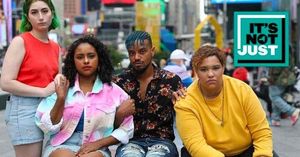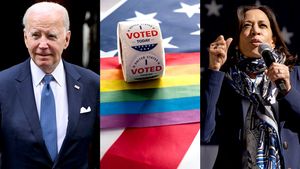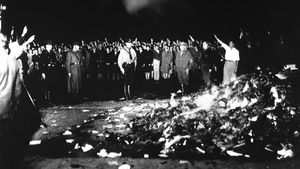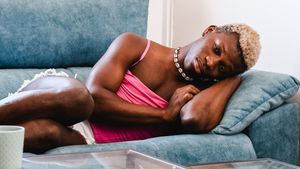It’s not nice to judge people by what they wear. And really, there are no rules for clothes. Nothing reads the same way in all cultures. Except, maybe, a jockstrap.
Even if it’s not gay, it’s still fuckboy. Still hot. In Berlin club culture, where all sartorial rules are thrown out, I still count on the boyish, sporty jockstrap, an American invention, as fairly reliable evidence that its wearer is a gay man like me. The jockstrap has not (yet) been fully co-opted by straights, and I hope it stays that way. Every red carpet now has a straight boy playing dress-up in what was, at one time, a very gay wardrobe. But the jockstrap feels different. It says something about you.
Maybe all underwear does. Underwear goes under the clothes, exists between dressed and undressed, public and private. A jockstrap, in particular, with its open ass, rides the line between dressed and nude. It’s lingerie for men. Its wearer is at least metrosexual. He likes to play.
I don’t go around asking guys what kind of underwear they have on, so I guess I could be wrong, but from what I see — and what I feel — the jockstrap is still ours. It still looks pretty damn gay to me.
That peekaboo strap over the butt, just above his pants line, does not shout for attention like those T-shirts with “Daddy” and “Cum Dump” printed across the chest, found in every gay clothing store now. A jockstrap growls subtly but hungrier. Hey bro, wanna see more?
 Broadway Bares 2024Josh Drake
Broadway Bares 2024Josh Drake
But why? Its journey from practical sports gear to a symbol of queer hedonism is hardly clear. We know some facts: Jockstraps, or jocks, go back to the cobblestone streets of 19th-century Boston. The first was designed in 1874 by C.F. Bennett for the Chicago sporting goods company Sharp & Smith. Early bicycles, called penny-farthings, had a big front wheel and tiny back wheel, and people who rode them were called “bicycle jockeys,” a term borrowed from horse racing. In Boston, male bicycle jockeys were, um, uncomfortable on the city’s rough, bumpy streets (I know the feeling). They needed support and protection for their junk. Thus, the first jockstrap was called a “bike jockey strap,” with a supportive front panel and two elastic straps wrapped around the legs.
From there, it moved to other activities. By the early 20th century, jockstraps were worn by football and rugby athletes. A hard plastic cup was added, making it ideal for contact sports. The mass production of jockstraps began in earnest in 1897 when Bennett formed the Bike Web Company, which later became the Bike Athletic Company.
Yes, for eagle-eyed jockstrap fans: that Bike. The Bike jockstrap was the first to be fetishized by gay men. They were discontinued for some years but returned in 2019 when Alex Angelchik and a team of investors bought the company.
“From the ’70s through today, the jockstrap became kind of a cult favorite within the gay community,” Angelchik told the Associated Press in March. He estimated that 70 percent of Bike customers were gay men and credits the jockstrap’s enduring popularity to gay buyers. Bike jocks still have the classic, no-frills look of sports gear.
 An early 20th century Bike jockstrap adCourtesy Bike Athletic
An early 20th century Bike jockstrap adCourtesy Bike Athletic
The jockstrap’s cultural significance took an unexpected turn in the mid-20th century. In the 1950s and 1960s, it became embraced by the gay community as a symbol of hypermasculinity. A new, masculine gay ethos was emerging that embraced (and parodied) the rugged aesthetics of stereotypically straight, blue-collar male types: construction workers, cowboys, bikers, and the like. Tom of Finland comics and muscle magazines like Physique Pictorial ensured that every newly empowered disco queen had a jockstrap for slutty nights out. Into the ’80s and the AIDS crisis, jockstraps stuck: Gay men lined the sidewalk outside the Saint in New York City, defiantly wearing jockstraps and leather during a decade of mounting loss and oppression.
From the Bike original, jocks moved into fashion. You can buy them now from Tom Ford, Versace, Calvin Klein, Armani, and Tommy Hilfiger, to name a few. Thom Browne included them in his spring/summer 2023 menswear collection and John Galliano sent fur coats and jocks down the runway in 2004. Today, they are increasingly found in edgier brands like Thug Club and AVAVAV. They have broached the echelons of high art in paintings and films by Andy Warhol, Tom Bianchi’s Polaroids, Bruce Weber’s generation-defining fashion photography, and more.
The jockstrap is now a fetish item, fashion statement, and (still!) a piece of gear for athletes. They still hold the charm of a rugged American archetype — a dumb, sexy athlete soaked in his own sweat.
 Courtesy Nasty Pig
Courtesy Nasty Pig
Some years ago, I messaged a queer T-shirt brand online: “Hey, you’re selling a T-shirt that is actually a photo of me. It’s no problem, but can I have one?”
They sent one and said sorry. I said it was no big deal. Technically, the image they ripped was the property of Out’s sister publication, The Advocate. They said they found it from a Google Image search and put it on a shirt without thinking much about it. They were not the only ones: I have seen it on other shirts, on postcards, illustrated, turned into enamel pins, retouched, and reposted in countless places online. Originally, the photo was the lead image of an article I wrote in 2016, “36 Fetishes Every Gay Man Should Know” — a photo of me with my head partially covered by a Nasty Pig jockstrap. I used my old iPhone camera.
In this way, I claim myself as a tiny part of jockstrap history — a history shaped in no small way by Nasty Pig itself. The gay clothing brand in New York City has so impacted the idea of jockstraps in gay culture that it’s hard to imagine them another way.
“Nasty Pig made the first jock specifically by a gay brand,” Nasty Pig CEO David Lauterstein told me. “We wanted to give our community a jock that was squarely aligned with a gay-owned and -operated vibe.”
Before Nasty Pig, jocks were mostly in simple, muted colors and rarely worn as daily underwear. Nasty Pig turned them into something you’d wear under your clothes to the office or gym — in countless colors, patterns, and fabrics.
“We built the gay uniform of ‘hat, jock, and sock’ as a staple of the gay sex wardrobe,” Lauterstein said. “I’m confident when I say that. It’s pretty fucking cool.”
 Bike Athletic Company released a limited edition jock for its150th anniversary.Bike Athletic Company
Bike Athletic Company released a limited edition jock for its150th anniversary.Bike Athletic Company
What inspired the brand’s aesthetic? “Thierry Mugler, Jean Paul Gaultier, Pat Field, Raymond Dragon, Tom of Finland, Falcon videos of the 1970s, Futura 2000, to name a few,” he said. “As for role models, many of our queer ancestors who came before me passed due to AIDS. We were really left to our own devices.”
For the brand’s 30th anniversary this year, Lauterstein will publish a book this fall calledSodomy Gods from Unbound Edition Press. “It’s a memoir of my husband, Fred, and I meeting and falling in love and starting the brand,” he said. “I wanted to share what it was like in the early ’90s so people have context of our history. We can be erased so easily if we take what we have now for granted.”
On the cover of Rolling Stone in February, out actor Kristen Stewart, sporting a Bike jock, proved they are no longer just for men: They are a teasing, implicitly queer-coded way for anyone to look hot and butch (Stewart was not the first cover girl to wear a jockstrap: Kim Kardashian wore one in 2022 for Interview magazine).
Yes, they are still #masc, but jocks have evolved the other way too. High-femme jockstraps in silk, with rhinestones and lace, are available at Exterface (also called EXSL), and circuit party brands like JJ Malibu and Andrew Christian have filled gay bar nights with bright jocks that go beyond their masculine roots.
 A porcelain jockstrap vase from Pansy Ass Ceramics KRIS/PANSYASS
A porcelain jockstrap vase from Pansy Ass Ceramics KRIS/PANSYASS
At Pansy Ass Ceramics, you can find porcelain jockstrap vases and sculptures painted in 14-karat gold. The Toronto-based company was founded by artist duo and couple Andy Walker and Kris Aaron in 2015. “The gay fascination with the jockstrap started in the locker room,” the duo said. “It is definitely a symbol of gay sexual liberation. It is the masculine jock energy with an exposed ass, ready to play ball. We feature the jock prominently in our work because it is ubiquitous in gay sex. It’s the initial tantalization before the clothes are on the floor.”
Clothes and perceptions change. But please, comrades, let’s keep this. Keep the jockstrap gay. Every week, more things seem broken in the world. Jockstraps are maybe a small thing to love, insignificant in the scheme of things, but I still remember being a baby gay, newly out, and wearing my first jock in a bar. That power in being fresh meat, open for play, is the same thing I want every new gay to feel, and I take comfort that, no matter what happens, some fella out there is feeling #himbo, feeling hot, with his bare ass under his clothes, begging to be licked.
Alexander Cheves is a writer, sex educator, and author of My Love Is a Beast: Confessions from Unbound Edition Press. @badalexcheves
This feature is part of Out's September/October issue, which hits newsstands on August 28. Support queer media and subscribe — or download the issue through Apple News, Zinio, Nook, or PressReader starting August 13.








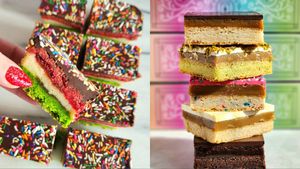

























 Broadway Bares 2024Josh Drake
Broadway Bares 2024Josh Drake An early 20th century Bike jockstrap adCourtesy Bike Athletic
An early 20th century Bike jockstrap adCourtesy Bike Athletic Courtesy Nasty Pig
Courtesy Nasty Pig Bike Athletic Company released a limited edition jock for its150th anniversary.Bike Athletic Company
Bike Athletic Company released a limited edition jock for its150th anniversary.Bike Athletic Company A porcelain jockstrap vase from Pansy Ass Ceramics KRIS/PANSYASS
A porcelain jockstrap vase from Pansy Ass Ceramics KRIS/PANSYASS









